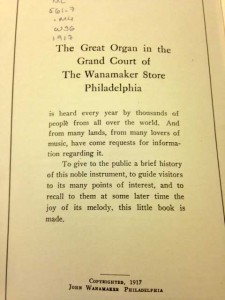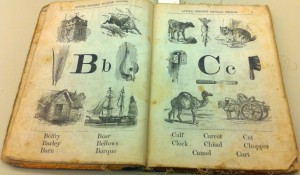The Poet & the President
[Posted by Judith Daly for AMST 851: The World of Rare Books (Instructor: Richard Ring)]
 American Studies stands at the crossroads of history and literature and I found an item in the Watkinson that is so apropos for the two topics. The Watkinson holds two copies of Dedication: And The Gift Outright by Robert Frost The Inaugural Address of John Fitzgerald Kennedy Washington, D.C., January the Twentieth, 1961.
American Studies stands at the crossroads of history and literature and I found an item in the Watkinson that is so apropos for the two topics. The Watkinson holds two copies of Dedication: And The Gift Outright by Robert Frost The Inaugural Address of John Fitzgerald Kennedy Washington, D.C., January the Twentieth, 1961.
Frost was the first poet to recite a poem at the inauguration of a president. Initially Kennedy asked Frost to recite “The Gift Outright;” a poem published two decades earlier. But the poet wrote a poem titled “Dedication”, specifically for the inauguration. However, he had little time to memorize it and when he tried to read it, he could only get a few lines in. The glare off of the snow on that January day was too bright for the elderly Frost to read. So he went back to the original plan and recited “The Gift Outright” from memory changing the phrase in the last line to “such as she will become” from “such as she would become” at the new president’s request.
Kennedy and Frost had a history. At a press conference before Kennedy even announced his candidacy, Frost predicted that the youthful Massachusetts senator would become the next president. It was at the Waldorf Astoria, prior to a gala to celebrate Frost’s 85th birthday. “Among the questions asked was one concerning the alleged decline of New England, to which Frost responded: ‘The next President of the United States will be from Boston. Does that sound as if New England is decaying?’ Pressed to name who Frost meant, he replied: ‘He’s a Puritan named Kennedy. The only Puritans left these days are the Roman Catholics. There. I guess I wear my politics on my sleeve.’”
Kennedy, in turn, would often close campaign speeches with two lines from the final stanza of “Stopping By The Woods on a Snowy Evening.”
“But I have promises to keep, / And miles to go before I sleep.”
Kennedy invited Frost to take part in the inauguration and the old poet replied via telegram: “If you can bear at your age the honor of being made President of the United States, I ought to be able at my age to bear the honor of taking some part in your inauguration. I may not be equal to it but I can accept it for my cause—the arts, poetry, now for the first time taken into the affairs of statesmen.”
Kennedy’s inaugural address is perhaps one of the most famous American speeches. (A number of lists online have it as the #2 American speech of the 20th Century after Martin Luther King’s “I Have a Dream.”) Both of Frost’s poem’s, along with Kennedy’s inaugural address appear in this short book.
The book itself was printed by Spiral Press. It was a limited edition. The Watkinson holds two of the 500 copies. Spiral Press was a small publisher run by Joseph Blumenthal. Blumenthal was a longtime collaborator with Frost. He met the poet in 1930 when Frost’s collected poems were published and he continued a relationship with him that lasted over three decades. Blumenthal was part of the fine-press movement. Blumenthal cared about the art of book design. He once said about his work that “Craftsmanship has always been the core, and I’ve always devoted a maximum of effort to every job, big or small, profitable or not, from a book to a business card. “ He was an artisan and he used high quality paper, vintage inks, and an old style typeface that he invented himself.
The typeface was originally called Spiral, after his publishing house. But once it became available commercially, the name was changed to Emerson. Emerson is a Roman typeface. It is noted for wide capitals and distinctive foot serifs of the lower-case a, d, and u. Louis Hoell first cut it in Frankfurt at the Bauer Type Foundry in 1930. It was then recut for the Monotype Corporation by Stanley Morison in 1935. It first appeared in an edition of Ralph Waldo Emerson’s Nature; thus, the name of the typeface. A distinguished calligrapher, Reynolds Stone, favorably cited the typeface in a review, “(Emerson) avoided the rigidity of a modern face and preserved some of the virtues of the classic Renaissance types.”
The book that I examined was copy 340 of 500. It is a thin volume; covered with wrappers of tissue. The title page says “Dedication. The Gift Outright. The Inaugural Address.” This is followed by the Presidential Seal and the location and date “Washington D.C. January the twentieth, 1961.” German artist and graphic designer Fritz Kredel created the woodcut of the Presidential Seal for Kennedy’s inauguration, which appears on the page The paper has a coarseness to it. The type is large. Legibility is one of the goals that the printer Blumenthal aimed for. “Fine printing,” he once wrote, “is not fancy printing. It is simply (if not so simple) an articulate search for clarity.














